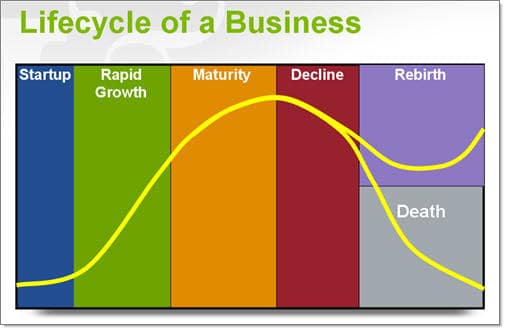I enjoyed reading PJ Chan’s post entitled 6 Tips for Building Innovation Into Your Company DNA. I agree with Ms. Chan’s assessment that, “innovation only happens in the right environment, one where everyone is not only allowed to innovate but they are actively encouraged to speak up and bring new ideas to the table.” Chan goes on to outline here six attributes for creating this type of corporate environment including:
- Encouraging people to feel free to innovate.
- Making innovation a social activity.
- Eliminating perfectionism and implementing rapid iterative processes to try test and evaluate and move on.
- Value failure lessons don’t avoid them.
- Model the innovation behaviors especially at top management.
- Resist using a project management approach to innovation.
One key phenomenon missing from this list and Ms. Chan’s post is an explanation of why innovation becomes more difficult as companies move through their natural lifecycle.

When a company first starts the corporate environment encourages entrepreneurialism. Experimentation and the high risk of trying new products and services are welcomed during the Startup stage. The company has not yet created a strong value chain, so the risk of innovation is much more advantageous because there is very little risk of alienating the customers, partners, and suppliers in a, yet to be established, value chain. However, that paradigm will change quickly once the company has defined the products and services that create the next phase in the company’s march towards maturity, the Rapid Growth phase. Often when a company enters this phase a signal that things have changed from an innovative to execution-based culture is the exodus of the original founders and employees that launched the company. A company that is growing no longer places great value in innovation and therefore the original founders no longer fit this new phase of the company. As the company changes from the frenetic phase and uncertainty of the Startup to the Growth stage new innovative ideas are valued less in comparison to ideas about how to best execute processes that produce rapid growth. And as a result, the skills and values of the entrepreneur are also less valued compared to excellent management and execution skills.
However, this very lifecycle eventually ends up creating a blind spot for the organization especially as it reaches maturity and continues to move up the value chain chasing more profitable growth. This is demonstrated by Professor Clayton Christensen in his models of innovation.
While sustaining innovations for products and services continue to move the company upstream in the value chain, this is not the type of innovation that most business leaders define as most desirable within their organizations once the company reaches maturity and growth of existing products and services starts to falter. In fact, sustaining innovations become less valued by a greater percentage of the company’s customers in comparison to the price. I don’t believe these sustaining innovations are what PJ Chan is espousing in her article. Instead, she and the leaders of companies experiencing declines in growth in the maturity stage want new growth from new innovative products and services. And this is exactly what is so difficult for these mature companies to produce. Christensen calls this the “innovator’s dilemma”.
This is the inflection point. A time when no matter how hard a leader tries to change her company’s environment, as PJ Chan describes, to produce disruptive new market innovations, the company continues a path of decline. At this inflection point, I would say that there is one key idea missing from Chan’s list. Who is the key, not what? Ms. Chan’s list describes the ‘what’ of the environment for innovation but the who is missing. You must have the right people that are less focused on the management of the current value chain and instead are focused on creating a new one. Without the right people, the changes necessary for real innovation will not happen. During a time where innovation is needed within the organization, it is imperative that the organization returns to its entrepreneurial roots and picks leaders and followers that have the personalities and skills of an entrepreneur like the original founders. These individuals will give the company the best opportunity to jump out of the forces of the current value chain and boldly create a new one. And this is exactly what’s needed for the company to embrace Chan’s list. Unfortunately, in many cases, the people that led the organization through the Rapid Growth and Maturity stages do not have the right skills and personalities to give the organization the best shot at Rebirth.
Therefore, when you find that your organization needs a new culture of innovation make sure you have not only defined what that looks like, as PJ Chan has, but don’t forget to evaluate the dispositions, personalities, and strengths of the individuals who will lead those innovation changes. Because if you don’t have the right people in place then the creation of the new innovative environment will not be achieved.